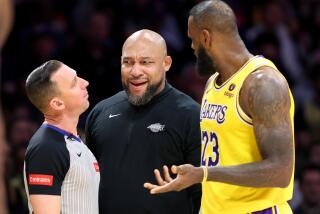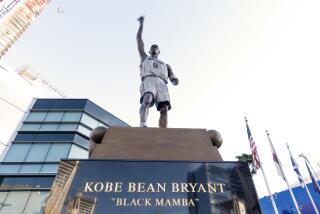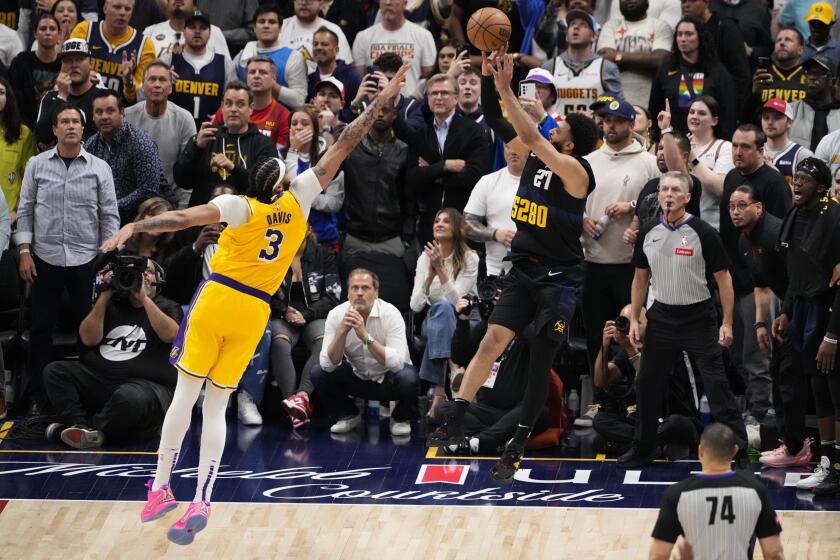Here’s hoping that Andrew Bynum hears this message loud and clear
Both emails arrived the same day.
One came from a reader with a picture attached of a very fancy sporty convertible parked across a white-and-blue painted handicapped space directly in front of a blue handicapped sign outside a Bank of America in Playa del Rey.
The emailer said it was Andrew Bynum‘s car.
“Does he care about the Laker image,” she wanted to know, “and respect for the people of Los Angeles?”
Maybe she was mistaken; another 7-foot-giant driving a fancy sporty convertible around as if he owns the town.
“The public is not always wrong,” replied a Lakers spokesman when asked if the emailer was correct.
The second email came from the Baseball Hall of Fame, relaying a statement from another giant of a man, Harmon Killebrew.
“It is with profound sadness that I share with you that my continued battle with esophageal cancer is coming to an end. With the continued love and support of my wife, Nita, I have exhausted all options with respect to controlling this awful disease. My illness has progressed beyond my doctor’s expectation of cure.
“I have spent the past decade of my life promoting hospice care and educating people on its benefits. I am very comfortable taking this next step and experiencing the compassionate care that hospice provides.
“I am comforted by the fact that I am surrounded by my family and friends. I thank you for the outpouring of concern, prayers and encouragement that you have shown me. I look forward to spending my final days in comfort and peace with Nita by my side.”
Maybe you never saw him play, but many will know Harmon Killebrew’s name and associate it with massive power and tape-measure home runs.
I met him at a basketball game in southern Idaho more than 35 years ago. I knew the reputation and was surprised to find a guy who didn’t even stand 6 feet tall.
To hear folks talk about him over the years, he seemed so much bigger.
I don’t remember much from that meeting, other than how cool it was to meet someone I had seen on occasion on TV. He was friendly, and the only celebrity I ever came across in Idaho.
I never gave him another thought and had no idea what he did with the rest of his life until I looked it up after seeing the email.
The Hall of Famer played 22 years, mostly for Minnesota, and has lived for another 36 beyond retirement — almost half a life lived beyond baseball, and yet his life is remembered best for the baseball he played.
Killebrew, 74, has nine children, 23 grandchildren and two great-grandchildren. Talk about accomplishments.
They named a street for him in Minnesota outside the Mall of America; he was a broadcaster and then a coach. He had financial problems, he and his wife divorced, his home went into foreclosure and his health suffered. He underwent three surgeries, nearly died, lived for a time in a wheelchair but recovered to get married to Nita more than 20 years ago.
He raised millions for leukemia research in the name of a former teammate who died, and started a foundation to help others.
He will be remembered most for hitting home runs, those around him remembering him for so much more, of course. But there would be no public statement alerting the world his fight with cancer is almost over — if he hadn’t hit those home runs.
It’s what makes an athlete like Harmon Killebrew a mileage marker for a generation that grew up in awe of his accomplishments. One generation passing its recollections on to the next, the memory a little dimmer with each telling.
But what a feeling to be reminded of childhood thrills, of the ultimate power of sports and those who play them, bringing everyone back home again.
Maybe a reputation meant more than it does now. I know I mentioned Harmon Killebrew to Tom Lasorda, and his face lit up. “If you wanted a kid looking up to somebody, you’d want it to be a guy like Harmon.”
Tough to make a case athletes should take the time to really care about anything today, when they are already getting paid millions, regardless if they are good guys or bad.
They don’t know it, but there is so little time for most athletes on center stage; that time, though, defines who they are to those who will never really know them.
It is what allowed someone like Killebrew to later raise millions for leukemia, to start a charity foundation and now — with just the mention of his name again — rekindle such fond memories from those who watched him play.
One emailer might remember Andrew Bynum now only as the 7-foot athlete who felt entitled to park his fancy car in a handicapped parking space.
Others might recall only his bizarre behavior: taking off his shirt and walking off the court after delivering a cheap shot.
Still others might wonder why Bynum didn’t make eye contact with them in their only meeting, a man looking beyond as if he would prefer to be anywhere but right here.
In looking up information on Killebrew, I came across a story written by Philadelphia writer Jim Salisbury four years ago. He asked Killebrew about baseball fans, and Killebrew said, “You never know. That might be the only time a person sees you play or meets you. I always tried to remember that.”
Killebrew’s life is ending, Bynum’s athletic journey just beginning, so much living yet to come.
What a great opportunity.
More to Read
Get our high school sports newsletter
Prep Rally is devoted to the SoCal high school sports experience, bringing you scores, stories and a behind-the-scenes look at what makes prep sports so popular.
You may occasionally receive promotional content from the Los Angeles Times.






